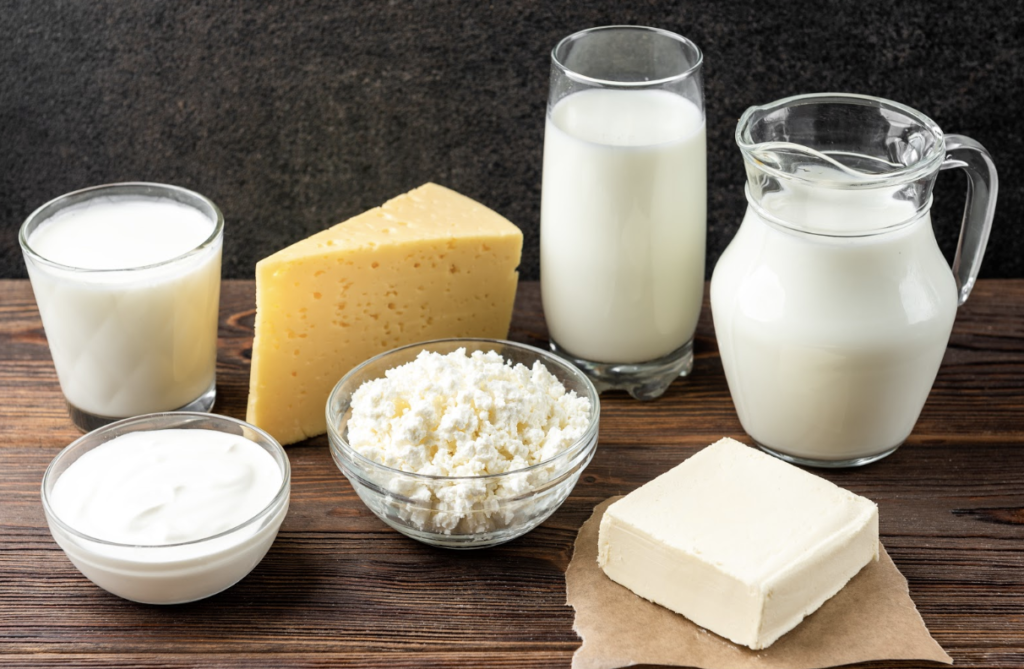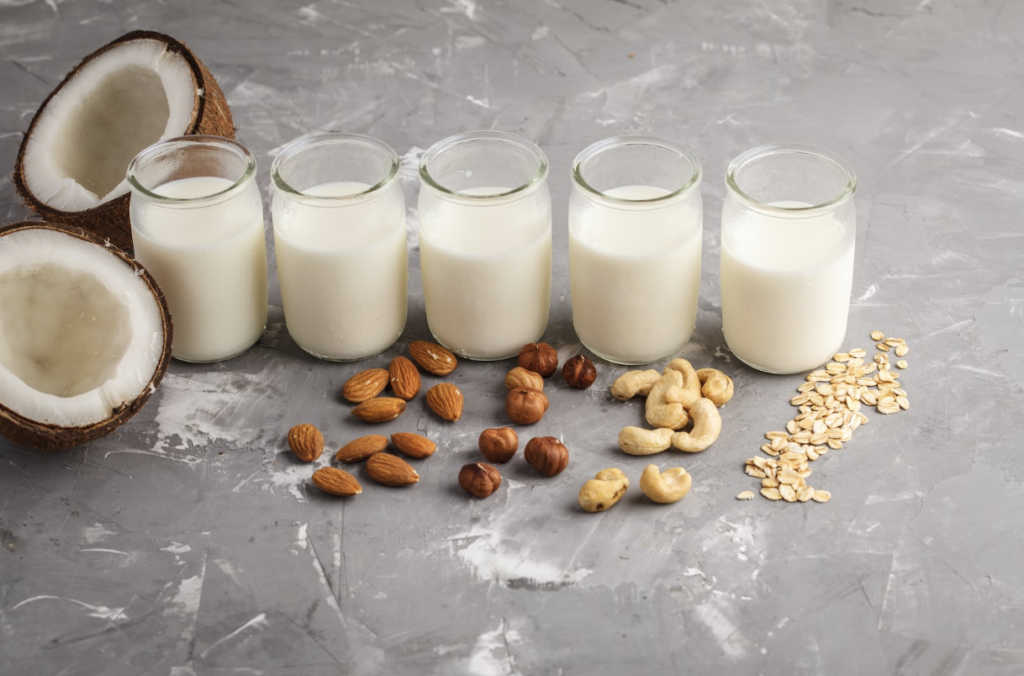If you were to shadow me in my clinic, you would hear me talk about the links between dairy and inflamed skin over and over and over again.
Now, I spent part of my childhood growing up in Wisconsin…yep I’m a “Cheesehead”! I LOVE LOVE LOVE cheese….sharp cheddar, extra sharp is my fav. (Oh and those “squeaky cheese” curds fresh from the dairy farm are quite tasty too if you’ve ever had them.)
But unfortunately for some of us, dairy products are not agreeing with our bodies and can contribute to issues in our gut and in our skin.
Cow’s milk contains a lot of nutrients and proteins to help the baby calves grow. Whey and casein are two proteins found in high amounts in cow’s milk that help the calves grow. Lactose is a sugar that is found milk. All of these components can lead to health issues in humans.
Whey and casein stimulate a hormone in us that acts like insulin and it’s called insulin-like growth factor (IGF). There are strong links between acne and dairy and IGF as increased IGF can lead to increased sebum production and acne breakouts.
Lactose intolerance occurs in people that are unable to digest the sugar lactose in milk as they usually don’t have the enzyme lactase or have very little of it. This can lead to gas, bloating, cramps, nausea, and/or diarrhea whenever dairy products are consumed.
One way to find out if dairy is the culprit to your inflammatory skin issue is to do a trial of eliminating it 100% from your nutrition for 3-6 weeks. Then reintroduce it into your nutrition plan and track your before and after symptoms.
Here are the 5 Steps to Implement a Successful Dairy Elimination Plan:
1. Define Dairy.
So first things first….what the heck is considered a dairy product?
Well, technically it’s anything that is derived from milk. Milk comes from mammalian animals and it seems that derivatives of cow’s milk are the culprit for most health associated issues with dairy.
Can I still eat eggs?
This does not include eggs as eggs are made from chickens and not cows. You may have a sensitivity to eggs, but that’s a whole other topic 🙂
Here’s a list of common dairy products:
- Milk
- Cheese
- Cottage Cheese
- Cream Cheese
- Cream
- Ice Cream
- Sour Cream
- Whipped Cream
- Half and Half
- Yogurt
- Butter
- Kefir
- Whey
- Casein
I can have Goat’s Milk then, right? What about sheep’s milk or camel milk?
It’s true that cow’s milk and goat’s milk are different, but many people that are sensitive to cow products are also sensitive to goat products. You may be less likely to react to sheep or camel’s milk as they are not part of a typical American nutrition plan.
Can’t I just change to organic dairy? Or raw milk? Or fermented dairy (kefir)?
Dairy is Dairy. Organic, raw, fermented…these all may be considered “healthier” versions of dairy, but it’s still dairy.
What about Ghee?
Ghee is clarified butter. It contains butterfat whereas butter contains butterfat and milk solids. Some people that are dairy sensitive can tolerate ghee because it does not have the milk solids, although some people are sensitive to both.
If you are going to see if you are truly sensitive to dairy, I would advise 100% elimination of all forms of dairy. Commit to this.
2. Hidden Dairy
Look at labels. Ask questions.
When you turn over your food boxes and look at the labels, you may be surprised to find dairy in some of your favorite foods.
Protein bars may contain whey protein which is a derivative of dairy. Some crackers, breads, boxed cereal, nut bars, deli meats, granola etc may contain milk. Look for words on the label such as casein, nonfat milk powder, whey protein, butterfat, milk solids etc.
When you order food at a restaurant, be sure to ask if an item is dairy-free or if it has milk, butter or cheese in it. You may be surprised to find out that milk is added to scrambled eggs. Anything mashed, like potatoes and maybe even mashed cauliflower may have milk added. Some salad dressings have added cheese and some soups may have cream and/or milk added.
3. Replace Dairy
You may still want to indulge in dairy-like foods while you are eliminating it and you can substitute with non-dairy options.
Some great options are available for dairy substitutes are:
- Coconut
- Almond
- Hemp
- Rice
- Flax
- Oat
- Cashew
- Walnut
- Macadamia
- Hazelnut
There are several “vegan cheeses” to choose from and cashew cheese is very tasty and is the closest I’ve come to real cheese flavor. But I haven’t found one yet that matches my indulgence of extra sharp cheddar cheese. If you know of one, please message me so I can try it!!
For cream cheese or a cheese like spread, I found the Kite Hill brand the closest to real cream cheese and they derive their product from almond milk.
Califa Farms has an excellent Almond/Coconut milk that goes well in smoothies etc.
Surprisingly, cauliflower can have a very cheesy taste to it. You may want to check out this recipe by Detoxinista to make cheese sauce with cauliflower.
Experiment with different brands of products and or homemade recipes and find one you like!
4. Keep track
Mark on your calendar the day you started to 100% eliminate dairy.
Keep track of what your skin issue looks like as time goes on.
Sometimes taking a quick selfie every day is the quickest way to summarize what your skin is doing.
You may also want to track your mood, stomach issues, joint pains, sleep, energy levels, focus, etc.
Rate your symptoms on a scale of 1 to 10 on their severity. Also have a place where you take notes on any other unique things you notice both positive and negative.
5. Reintroduce Dairy
At the 3 week mark, take a look at the progression of your skin issue.
If it’s improved to the point where you think you will be able to tell if it changes when you reintroduce dairy, then go for it.
If you feel like you may need another week or two, then hold out for a few more weeks.
Some people are really sensitive to dairy and notice a difference right away, others it seems to take a little bit longer to tell, but you should notice a difference if there is going to be one in 3-6 weeks as long as you have been diligent about avoiding dairy.
Obviously if you have still had dairy in your food plan, then you won’t be able to tell as clearly if it’s related to your skin issues.
If your symptoms never seem to improve, then there are likely other factors at play and you can certainly reintroduce dairy and see if things worsen or if it’s completely unrelated.
The Reintroduction
To reintroduce dairy, I recommend starting slow and stick with organic dairy when you can.
The reintroduction phase is the most important part of this process. You have done all of the work of diligently eliminating dairy up until this point, now it’s time to see if dairy is a true issue with your skin concerns.
Do this part carefully and slowly.
Eat dairy a few times per day for 2-3 days in a row and then stop eating it again and wait the rest of the week or so to see if any of your symptoms are coming back.
This is an important time to be consistent about tracking your symptoms.
If you notice a pimple breakout or a symptom coming back then stop dairy and wait until it clears before you trial it again.
After the symptom has resolved, if you would like to brave it out again and try to reintroduce it again 2-3 times per day for 2-3 days and recheck for flare of your symptoms you can. If you really are reacting to dairy it might be worth re-testing it to be sure.
If you want to test out what type of dairy you are reacting to, then introduce one type of dairy at a time.
For example, you may want to start out with something that is less reactive for most like butter or ghee. And if no reactions, then introduce another type of dairy like yogurt. And so on.
If no reactions happen that seem related to dairy reintroduction, then dairy is unlikely an issue for your current skin issue. If it is, well then you know when you eat dairy how your body will respond. It’s all about knowing your body and how it interacts with certain foods.
What if I accidentally (or intentionally) eat some dairy sneaks in during the elimination time?
Well, it happens. Don’t beat yourself up and recommit to eliminating dairy 100% and try again. If you can’t eliminate dairy, then you may never clearly know if it’s a contributing issue.
You will learn something about your body’s relationship with food by doing this trial of eliminating dairy and hopefully it unveils some clues into how foods may be contributing to your health and skin issue.


